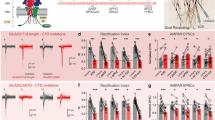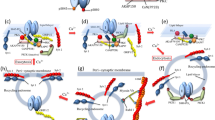Abstract
Although long-term depression (LTD) of AMPA receptor–mediated postsynaptic currents (AMPAR EPSCs) has been extensively examined, little is known about the mechanisms responsible for LTD of NMDA receptor (NMDAR)-mediated EPSCs. Here we show differences in the intracellular signaling cascades that mediate LTD of AMPAR EPSCs versus NMDAR EPSCs in rat hippocampus. Both forms of LTD were blocked by inhibitors of protein phosphatase 1, but only LTD of AMPAR EPSCs was affected by inhibition of calcineurin. Notably, in contrast to LTD of AMPAR EPSCs, LTD of NMDAR EPSCs was unaffected by endocytosis inhibitors. A role for calcium-dependent actin depolymerization in LTD of NMDAR EPSCs was supported by the findings that the actin stabilizer phalloidin and a cofilin inhibitory peptide each blocked LTD of NMDAR EPSCs but not AMPAR EPSCs. These results suggest that the same pattern of afferent activity elicits depression of AMPAR- and NMDAR-mediated synaptic responses by means of distinct triggering and expression mechanisms.
This is a preview of subscription content, access via your institution
Access options
Subscribe to this journal
Receive 12 print issues and online access
$209.00 per year
only $17.42 per issue
Buy this article
- Purchase on Springer Link
- Instant access to full article PDF
Prices may be subject to local taxes which are calculated during checkout








Similar content being viewed by others
References
Malenka, R.C. & Bear, M.F. LTP and LTD: an embarrassment of riches. Neuron 44, 5–21 (2004).
Watt, A.J., Sjostrom, P.J., Hausser, M., Nelson, S.B. & Turrigiano, G.G. A proportional but slower NMDA potentiation follows AMPA potentiation in LTP. Nat. Neurosci. 7, 518–524 (2004).
Gean, P.W. & Lin, J.H. D-2-amino-5-phosphonovaleate blocks induction of long-term depression of the NMDA receptor-mediated synaptic component in rat hippocampus. Neurosci. Lett. 158, 170–172 (1993).
Xiao, M.Y., Wigstrom, H. & Gustafsson, B. Long-term depression in the hippocampal CA1 region is associated with equal changes in AMPA and NMDA receptor-mediated synaptic potentials. Eur. J. Neurosci. 6, 1055–1057 (1994).
Selig, D.K., Hjelmstad, G.O., Herron, C., Nicoll, R.A. & Malenka, R.C. Independent mechanisms for long-term depression of AMPA and NMDA responses. Neuron 15, 417–426 (1995).
Montgomery, J.M. & Madison, D.V. State-dependent heterogeneity in synaptic depression between pyramidal cell pairs. Neuron 33, 765–777 (2002).
Xie, X., Berger, T.W. & Barrionuevo, G. Isolated NMDA receptor-mediated synaptic responses express both LTP and LTD. J. Neurophysiol. 67, 1009–1013 (1992).
Dingledine, R., Borges, K., Bowie, D. & Traynelis, S.F. The glutamate receptor ion channels. Pharmacol. Rev. 51, 7–61 (1999).
Kotecha, S.A. & MacDonald, J.F. Signaling molecules and receptor transduction cascades that regulate NMDA receptor-mediated synaptic transmission. Int. Rev. Neurobiol. 54, 51–106 (2003).
Carroll, R.C., Beattie, E.C., Von Zastrow, M. & Malenka, R.C. Role of AMPA receptor endocytosis in synaptic plasticity. Nat. Rev. Neurosci. 2, 315–324 (2001).
Vissel, B., Krupp, J.J., Heinemann, S.F. & Westbrook, G.L. A use-dependent tyrosine dephosphorylation of NMDA receptors is independent of ion flux. Nat. Neurosci. 4, 587–596 (2001).
Nong, Y. et al. Glycine binding primes NMDA receptor internalization. Nature 422, 302–307 (2003).
Roche, K.W. et al. Molecular determinants of NMDA receptor internalization. Nat. Neurosci. 4, 794–802 (2001).
Morishita, W. et al. Regulation of synaptic strength by protein phosphatase 1. Neuron 32, 1133–1148 (2001).
Lisman, J. A mechanism for the Hebb and the anti-Hebb processes underlying learning and memory. Proc. Natl. Acad. Sci. USA 86, 9574–9578 (1989).
Mulkey, R.M., Endo, S., Shenolikar, S. & Malenka, R.C. Involvement of a calcineurin/inhibitor-1 phosphatase cascade in hippocampal long-term depression. Nature 369, 486–488 (1994).
Lüscher, C. et al. Role of AMPA receptor cycling in synaptic transmission and plasticity. Neuron 24, 649–658 (1999).
Schmid, S.L., McNiven, M.A. & De Camilli, P. Dynamin and its partners: a progress report. Curr. Opin. Cell Biol. 10, 504–512 (1998).
Carroll, R.C. et al. Dynamin-dependent endocytosis of ionotropic glutamate receptors. Proc. Natl. Acad. Sci. USA 96, 14112–14117 (1999).
Marie, H., Morishita, W., Yu, X., Calakos, N. & Malenka, R.C. Generation of silent synapses by acute in vivo expression of CaMKIV and CREB. Neuron 45, 741–752 (2005).
Zhang, S., Ehlers, M.D., Bernhardt, J.P., Su, C.T. & Huganir, R.L. Calmodulin mediates calcium-dependent inactivation of N-methyl-D-aspartate receptors. Neuron 21, 443–453 (1998).
Wyszynski, M. et al. Competitive binding of alpha-actinin and calmodulin to the NMDA receptor. Nature 385, 439–442 (1997).
Rosenmund, C. & Westbrook, G.L. Calcium-induced actin depolymerization reduces NMDA channel activity. Neuron 10, 805–814 (1993).
Sattler, R., Xiong, Z., Lu, W.Y., MacDonald, J.F. & Tymianski, M. Distinct roles of synaptic and extrasynaptic NMDA receptors in excitotoxicity. J. Neurosci. 20, 22–33 (2000).
Lei, S., Czerwinska, E., Czerwinski, W., Walsh, M.P. & MacDonald, J.F. Regulation of NMDA receptor activity by F-actin and myosin light chain kinase. J. Neurosci. 21, 8464–8472 (2001).
Krupp, J.J., Vissel, B., Thomas, C.G., Heinemann, S.F. & Westbrook, G.L. Interactions of calmodulin and alpha-actinin with the NR1 subunit modulate Ca2+-dependent inactivation of NMDA receptors. J. Neurosci. 19, 1165–1178 (1999).
Furukawa, K. et al. The actin-severing protein gelsolin modulates calcium channel and NMDA receptor activities and vulnerability to excitotoxicity in hippocampal neurons. J. Neurosci. 17, 8178–8186 (1997).
Kim, C.H. & Lisman, J.E. A role of actin filament in synaptic transmission and long-term potentiation. J. Neurosci. 19, 4314–4324 (1999).
Carlisle, H.J. & Kennedy, M.B. Spine architecture and synaptic plasticity. Trends Neurosci. 28, 182–187 (2005).
Witke, W. et al. Hemostatic, inflammatory, and fibroblast responses are blunted in mice lacking gelsolin. Cell 81, 41–51 (1995).
dos Remedios, C.G. et al. Actin binding proteins: regulation of cytoskeletal microfilaments. Physiol. Rev. 83, 433–473 (2003).
Zhou, Q., Homma, K.J. & Poo, M.M. Shrinkage of dendritic spines associated with long-term depression of hippocampal synapses. Neuron 44, 749–757 (2004).
Ehlers, M.D., Zhang, S., Bernhadt, J.P. & Huganir, R.L. Inactivation of NMDA receptors by direct interaction of calmodulin with the NR1 subunit. Cell 84, 745–755 (1996).
Mulkey, R.M., Herron, C.E. & Malenka, R.C. An essential role for protein phosphatases in hippocampal long-term depression. Science 261, 1051–1055 (1993).
Rosenmund, C., Feltz, A. & Westbrook, G.L. Calcium-dependent inactivation of synaptic NMDA receptors in hippocampal neurons. J. Neurophysiol. 73, 427–430 (1995).
Li, B. et al. Differential regulation of synaptic and extra-synaptic NMDA receptors. Nat. Neurosci. 5, 833–834 (2002).
Carroll, R.C., Lissin, D.V., von Zastrow, M., Nicoll, R.A. & Malenka, R.C. Rapid redistribution of glutamate receptors contributes to long-term depression in hippocampal cultures. Nat. Neurosci. 2, 454–460 (1999).
Ehlers, M.D. Reinsertion or degradation of AMPA receptors determined by activity-dependent endocytic sorting. Neuron 28, 511–525 (2000).
Lin, J.W. et al. Distinct molecular mechanisms and divergent endocytotic pathways of AMPA receptor internalization. Nat. Neurosci. 3, 1282–1290 (2000).
Man, H.-Y. et al. Regulation of AMPA receptor-mediated synaptic transmission by clathrin-dependent receptor internalization. Neuron 25, 649–662 (2000).
Allison, D.W., Gelfand, V.I., Spector, I. & Craig, A.M. Role of actin in anchoring postsynaptic receptors in cultured hippocampal neurons: differential attachment of NMDA versus AMPA receptors. J. Neurosci. 18, 2423–2436 (1998).
Wenthold, R.J., Prybylowski, K., Standley, S., Sans, N. & Petralia, R.S. Trafficking of NMDA receptors. Annu. Rev. Pharmacol. Toxicol. 43, 335–358 (2003).
Tovar, K.R. & Westbrook, G.L. Mobile NMDA receptors at hippocampal synapses. Neuron 34, 255–264 (2002).
Groc, L. et al. Differential activity-dependent regulation of the lateral mobilities of AMPA and NMDA receptors. Nat. Neurosci. 7, 695–696 (2004).
Okamoto, K., Nagai, T., Miyawaki, A. & Hayashi, Y. Rapid and persistent modulation of actin dynamics regulates postsynaptic reorganization underlying bidirectional plasticity. Nat. Neurosci. 7, 1104–1112 (2004).
Li, B., Otsu, Y., Murphy, T.H. & Raymond, L.A. Developmental decrease in NMDA receptor desensitization associated with shift to synapse and interaction with postsynaptic density-95. J. Neurosci. 23, 11244–11254 (2003).
Cummings, J.A., Mulkey, R.M., Nicoll, R.A. & Malenka, R.C. Ca2+ signaling requirements for long-term depression in the hippocampus. Neuron 16, 825–833 (1996).
Nagerl, U.V., Eberhorn, N., Cambridge, S.B. & Bonhoeffer, T. Bidirectional activity-dependent morphological plasticity in hippocampal neurons. Neuron 44, 759–767 (2004).
Acknowledgements
We thank S.Y. Lee for technical assistance and members of the Malenka lab for constructive comments. This work was supported by US National Institutes of Health grant MH063394 to R.C.M.
Author information
Authors and Affiliations
Corresponding author
Ethics declarations
Competing interests
The authors declare no competing financial interests.
Supplementary information
Supplementary Fig. 1
Schematic diagram illustrating working model of the different signal transduction pathways involved in LTD of AMPAR EPSCs and LTD of NMDAR EPSCs. (PDF 907 kb)
Rights and permissions
About this article
Cite this article
Morishita, W., Marie, H. & Malenka, R. Distinct triggering and expression mechanisms underlie LTD of AMPA and NMDA synaptic responses. Nat Neurosci 8, 1043–1050 (2005). https://doi.org/10.1038/nn1506
Received:
Accepted:
Published:
Issue Date:
DOI: https://doi.org/10.1038/nn1506
This article is cited by
-
Social isolation suppresses actin dynamics and synaptic plasticity through ADF/cofilin inactivation in the developing rat barrel cortex
Scientific Reports (2017)
-
Sinomenine attenuates chronic inflammatory pain in mice
Metabolic Brain Disease (2017)
-
PLPP/CIN regulates bidirectional synaptic plasticity via GluN2A interaction with postsynaptic proteins
Scientific Reports (2016)
-
Social deficits in IRSp53 mutant mice improved by NMDAR and mGluR5 suppression
Nature Neuroscience (2015)
-
ADF/cofilin: a crucial regulator of synapse physiology and behavior
Cellular and Molecular Life Sciences (2015)



